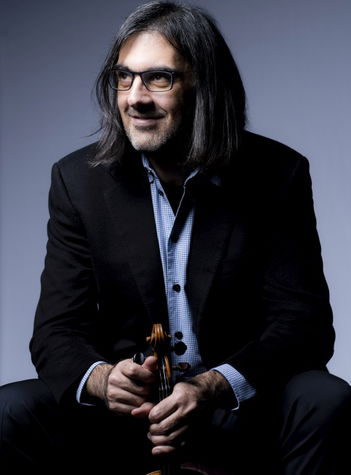Programme
Wolfgang Amadeus Mozart
Violin Concerto No. 3 in G major, K 216
Sergei Prokofiev
Symphony No. 6 in E flat minor, Op. 111
Secure your seat for the 2025/2026 season – presales are open.
Choose Subscription
Wolfgang Amadeus Mozart
Violin Concerto No. 3 in G major, K 216
Sergei Prokofiev
Symphony No. 6 in E flat minor, Op. 111
Leonidas Kavakos violin, conductor
Czech Philharmonic

Leonidas Kavakos violin

Leonidas Kavakos is recognized across the world as a violinist and artist of rare quality, acclaimed for his matchless technique, his captivating artistry and his superb musicianship, and the integrity of his playing. He works regularly with the world’s greatest orchestras and conductors and plays as recitalist in the world’s premier recital halls and festivals.
Kavakos has developed close relationships with major orchestras such as the Vienna Philharmonic Orchestra, Berliner Philharmoniker, Royal Concertgebouw Orchestra, London Symphony Orchestra and Gewandhausorchester Leipzig. Kavakos also works closely with the Dresden Staatskapelle, Bayerischer Rundfunk, Munich Philharmonic and Budapest Festival orchestras, Orchestre de Paris, Academia Nazionale di Santa Cecilia, Orchestra Filarmonica della Scala.
In recent years, Kavakos has succeeded in building a strong profile as a conductor and has conducted the New York Philharmonic, Houston Symphony, Dallas Symphony, Vienna Symphony, Chamber Orchestra of Europe, Maggio Musicale Fiorentino, Filarmonica Teatro La Fenice, and the Danish National Symphony Orchestra. Most recently he had a great success conducting the Israel Philharmonic.
In the 2022/2023 season, Kavakos is honoured as Artist in Residence at Orquesta y Coro Nacionales de España, where he will appear as both violinist and conductor across the season. He will tour Europe with Yuja Wang, as well as return to the US with regular recital partners Emanuel Ax and Yo-Yo Ma. Kavakos will perform a number of concerts throughout Europe and the Middle East with the Royal Concertgebouw Orchestra and Daniel Harding, as well as return to the Vienna Philharmonic, Bayerischen Rundfunks Symphony Orchestra, Deutsches Symphonie-Orchester Berlin, Orchestre Philharmonique de Radio France, NDR Hamburg, the New York Philharmonic and the Czech Philharmonic. He will also conduct the Danish National Symphony Orchestra, RAI Torino and the Minnesota Orchestra. He has two extensive visits to Asia, including a residency at Tongyeong International Music Festival, in addition to a series of recitals in Japan and South Korea where he will perform Bach’s Partitas and Sonatas, following the release of his critically acclaimed album “Bach: Sei Solo” in 2022.
Kavakos is an exclusive recording artist with Sony Classics. Further recent releases from the Beethoven 250th Anniversary year include the Beethoven Violin Concerto which he conducted and played with the Bavarian Radio Symphony, and the rerelease of his 2007 recording of the complete Beethoven Sonatas with Enrico Pace, for which he was named Echo Klassik Instrumentalist of the year. In 2022 Kavakos released “Beethoven for Three: Symphonies Nos. 2 and 5” arranged for trio, with Emanuel Ax and Yo-Yo Ma. The second album from this series containing further arrangements of Beethoven Symphonies will be released in Autumn 2022.
Born and brought up in a musical family in Athens, Kavakos curates an annual violin and chamber-music masterclass in Athens, which attracts violinists and ensembles from all over the world. He plays the “Willemotte” Stradivarius violin of 1734.
Wolfgang Amadeus Mozart
Concerto for Violin and Orchestra No. 3 in G Major, KV 216
During his life, Wolfgang Amadeus Mozart composed five violin concertos, the first in 1773, the other ones in 1775. In them he capitalized on the experience from his trips to Italy, the knowledge of French music and the inspiration drawn from Josef Mysliveček, a Czech composer living in Italy. Concerto for Violin and Orchestra No. 3 in G major, KV 216 was heard for the first time at the court of the Salzburg archbishop; it was probably performed by the court violinist Antonio Brunetti. The composition modeled after Vivaldi consists of three movements. Mozart borrowed the theme of the opening energetic Allegro from his opera Il re pastore; he did it not because he would lack inventiveness, but rather because this theme was more suitable for the violin than for singing. The enchanting Adagio with a dance central section played by woodwind instruments is followed by Rondeau, which quotes from at least one French folk tune. Mozart ends the whole concerto with his characteristic unpredictability: instead of an orchestral tutti, the listeners are bid farewell by the woodwind section in the weakened dynamics, evoking a feeling of disappearing music.
Sergei Prokofiev
Symphony No. 6 in E flat minor, Op. 111